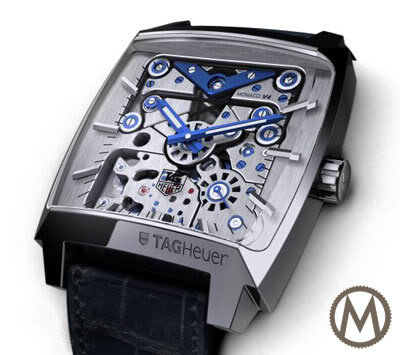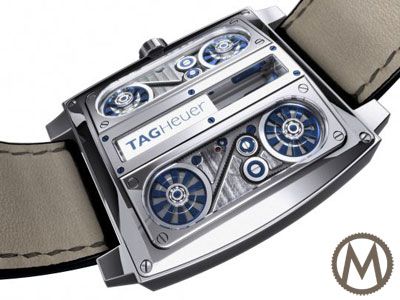TAG Heuer Monaco V4 Concept Watch

TAG Heuer presented a truly innovative watch, the Monaco V4 Concept Watch. Inside is a mechanical movement where traditional pinions have been replaced by drive belts.
Through time TAG Heuer has gained the name to be pioneer in chronograph development. Already in 1887 the company patented the oscillating pinion, an essential component in mechanical chronographs. And there are more innovations that led to this name:
- 1916 – Heuer developed the Micrograph stopwatch with 1/100th of a second accuracy
- 1969 – the first automatic chronograph Chronomatic Calibre 11
- 2002 – the Microtimer was first Swiss wristwatch accurate to 1/1000th of a second
At Baselworld 2004 TAG Heuer presented something completely new and revolutionary…. What was it? It was the Monaco V4 Concept Watch.

The pinions of the traditional movement are replaced with a series of toothed drive belts. The oscillating weight traditionally used to wind an automatic watch has been replaced by a linear oscillating weight that moves along a track between the watch’s four spring barrels. The four barrels are aligned two-by-two and are linked by a V-shaped bridge (hence the name of the model) and angled at 15° with respect to the dial. A gear system engages a cog and then translates the linear movement into a rotating movement. For the rotating parts, ceramic roller bearings are used instead of the standard synthetic rubies.
Now that sounds interesting, doesn’t? I’m blown away by this incredible and revolutionary idea. Especially now i know the belts are only 0.5 mm thick, while a human hair from the head measures around the 0.9 mm. TAG Heuer plans to present this watch as part of the regular collection in a few years. And it’s movement will have a COSC qualified movement with three-day power reserve!! Nice… TAG Heuer, very nice!!

Unfortunately, like more revolutionary ideas, the Monaco V4 was greeted with mixed emotions. Maybe it’s a matter of liking the design? Personally i really like both the design and the revolutionary techniques of the V4. By the way, the name V4 derives from the movement’s four barrels, which are mounted on a V-shaped main plate angled at 15 degrees, like cylinders in a high-end racing engine.
More details at www.tagheuer.com.



